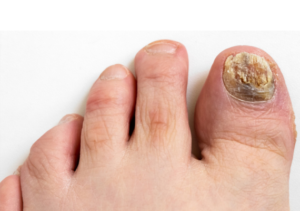Toenail fungus, also known as onychomycosis, is a common condition that causes the toenails to become thickened, discolored, and brittle. Fungal infections can affect one or multiple nails and are often persistent and difficult to treat.
Causes of Toenail Fungus
- Fungal Organisms: The most common cause is dermatophytes, but yeasts and molds can also infect the nails.
- Warm, Moist Environments: Fungi thrive in environments like locker rooms, public showers, and swimming pools.
- Nail Injuries: Cracks in the nail or skin can allow fungi to enter.
- Reduced Blood Circulation: Conditions like diabetes or peripheral artery disease can increase the risk.
- Weakened Immune System: Those with weakened immune systems are more susceptible to fungal infections.

